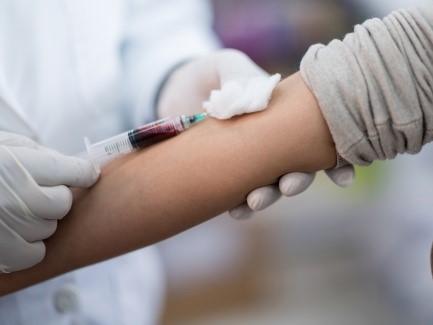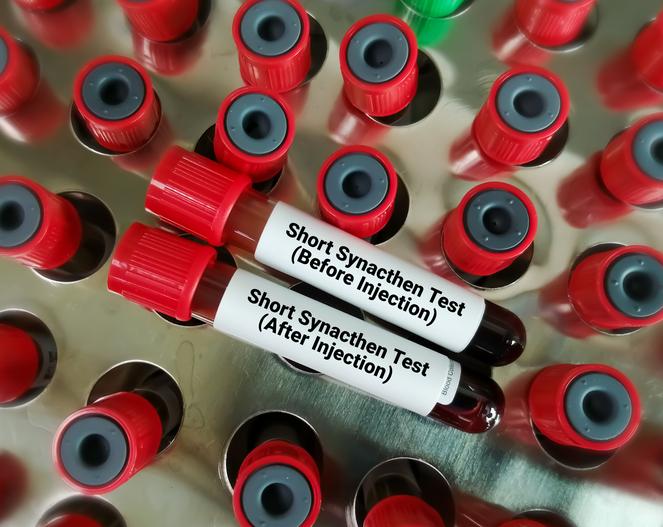Blood tests to detect inflammation
Peer reviewed by Dr Rachel Hudson, MRCGPLast updated by Dr Colin Tidy, MRCGPLast updated 1 Aug 2024
Meets Patient’s editorial guidelines
- DownloadDownload
- Share
- Language
- Discussion
If you have inflammation in a part of your body then certain types of extra protein are often released from the site of inflammation and circulate in the bloodstream. Healthcare professionals use a blood test for inflammation to assess if any inflammation is happening in a person's body. The tests are not very specific and many different types of conditions can affect the blood result. More investigations may be needed to sort out the exact cause of the problem.
In this article:
Continue reading below
What blood tests indicate inflammation?
The commonly used blood tests for inflammation include:
Erythrocyte sedimentation rate (ESR).
C-reactive protein (CRP).
Procalcitonin (PCT).
Plasma viscosity (PV).
These blood tests are commonly used to detect increase in protein in the blood. In this way they are used as markers of inflammation.
Note: the information below is a general guide only. The arrangements, and the way the inflammation blood test is performed, may vary between different hospitals. Always follow the instructions given by your doctor or local hospital.
Erythrocyte sedimentation rate (ESR) blood test
A blood sample is taken and put in a tube that contains a chemical to stop blood clots forming. The tube is left to stand upright. The red blood cells (erythrocytes) gradually fall to the bottom of the tube (as a sediment). The clear liquid plasma is left at the top.
The ESR measures the rate at which the red blood cells separate from the plasma and fall to the bottom of a test tube. The rate is measured in millimetres per hour (mm/hr). This is easy to measure as there will be a number of millimetres of clear liquid at the top of the red blood after one hour.
If certain proteins cover red cells, these will stick to each other and cause the red cells to fall more quickly. So, a high ESR indicates that you have some inflammation, somewhere in the body.
Levels of ESR are generally higher in females. Also the level increases with increasing age.
Continue reading below
C-reactive protein (CRP) blood test
CRP is a protein that is sometimes called an acute phase protein or acute phase reactant. This means that the level of CRP increases when you have certain diseases which cause inflammation. CRP can be measured in a blood sample. The CRP test measures the level of one specific protein, whereas the ESR takes account of many proteins.
Procalcitonin (PCT) blood test
Procalcitonin is usually produced in the thyroid but when there is a bacterial infection present, PCT can be produced by other organs. It is released into the blood stream. It is an extremely sensitive marker for pneumonia and sepsis (more sensitive than CRP) and how the conditions are progressing or responding to treatment. It can be used in hospitals to diagnose sepsis and guide antibiotic treatment.
Continue reading below
Plasma viscosity (PV) blood test
The conditions which the ESR test monitors can also be monitored by the PV test. It is another marker of inflammation. However, it is more difficult to perform and is not as widely used as ESR testing.
What are the normal values for ESR, CRP, PCT and PV?
ESR: the normal range is 0-22 mm/hr for men and 0-29 mm/hr for women.
CRP: most people without any underlying health problem have a CRP level less than 3 mg/L and nearly always less than 10 mg/L.
PCT: levels above 0.25mcg/L suggest chest infection; levels above 0.5ng/mL can confirm sepsis.
PV: the normal range for adults is 1.50-1.72 mPA.
These 'normal ranges' provide a guide. However CRP, ESR, PCT and PV levels can vary with factors such as age, pregnancy and between different hospital laboratories. The importance of the test result therefore needs to be considered in the context of each individual person.
What conditions affect the erythrocyte sedimentation rate and C-reactive protein level?
Raised ESR, CRP and PV levels are all markers of inflammation. Generally, PV and ESR do not change as rapidly as CRP does, either at the start of inflammation or as it goes away. CRP is not affected by as many other factors as the PV or ESR, making it a better marker of some types of inflammation. PV, however, is more sensitive and more specific than either ESR or CRP when monitoring the activity of rheumatoid arthritis.
ESR, CRP and PV can be raised in many inflammatory conditions - for example:
Certain infections (mainly bacterial infections).
Rheumatoid arthritis.
Various muscular and connective tissue disorders that have chronic inflammation as a feature - for example, polymyalgia rheumatica, giant cell arteritis or systemic lupus erythematosus.
Some cancers - for example, myeloma and Hodgkin's lymphoma.
Crohn's disease (inflammatory bowel disease).
Rejection of an organ transplant.
After operations.
Some conditions lower the ESR - for example:
It is also lowered in conditions where your body has lower protein levels - for example, in some liver or kidney diseases.
Procalcitonin levels are only used for pneumonia and sepsis. PCT is more sensitive than CRP so is a better marker for sepsis.
When are these blood tests used?
Inflammation blood tests are often used to assess whether symptoms may be due to any underlying inflammatory condition, eg, whether joint pain may be caused by rheumatoid arthritis, or whether bowel symptoms may be due to inflammatory bowel disease. However, the blood tests for inflammation are not specific for any particular condition.
Blood tests for inflammation are also sometimes used to help monitor long term (chronic) conditions such as rheumatoid arthritis.
To help diagnose diseases
ESR, CRP, PCT and PV are nonspecific tests. In other words, a raised level means that 'something is going on' but further tests will be needed to clarify exactly what that is. For example, you may be unwell but the cause may not be clear. A raised ESR, CRP, PCT and PV may indicate that some inflammatory condition is likely to be the cause. This may prompt a doctor to do further tests to find the cause. PCT is more specific for pneumonia and sepsis and is used to support a possible diagnosis to enable treatment to start quickly.
It is not usually possible to make a diagnosis of a certain condition just from a raised ESR, CRP, PCT or PV level.
However, before you have further tests, your doctor may suggest that you have the ESR, CRP, PCT or PV test repeated after a period of several weeks or months. If it has been raised by a recent infection (a very common cause) then it is likely to return to normal when your infection improves. You would not then need any further tests.
To monitor the activity of certain diseases
For example, if you have polymyalgia rheumatica, the amount of inflammation and disease activity can partially be assessed by measuring one of these blood tests. As a rule, the higher the level, the more active the disease. The response to treatment may also be monitored, as the level of ESR, CRP, PCT and PV may fall if the condition is responding well to treatment.
All the tests are useful. However, changes in the CRP and PCT are more rapid. So, for example, a fall in the CRP or PCT (for pneumonia) within days of starting treatment for certain conditions is a useful way of knowing that treatment is working.
This may be important to know when treating a serious infection or a severe flare-up of an inflammatory condition. For example, if the CRP level does not fall, it may indicate that the treatment is not working and may prompt a doctor to switch to a different treatment.
Does inflammation always show up in blood tests?
Inflammation does not always show up on inflammation blood tests (false negative), and blood tests for inflammation are also often raised without any inflammation (false positive). Therefore, the results must be interpreted carefully, and together with the symptoms.
Patient picks for Blood tests

Tests and investigations
Blood tests
The main reasons to know your blood group are if you need to have a blood transfusion or if you are pregnant. You cannot request a blood test just to know your blood group on the NHS.
by Dr Hayley Willacy, FRCGP

Tests and investigations
Synacthen test
A synacthen test checks the function of the adrenal glands. It can help to see whether the adrenal glands are producing enough steroid hormone (cortisol). Note: the information below is a general guide only. The arrangements, and the way tests are performed, often vary between different hospitals. Always follow the instructions given by your doctor or local hospital.
by Dr Philippa Vincent, MRCGP
Further reading and references
- Nehring SM, Goyal A, Patel BC; C Reactive Protein. StatPearls, July 2023.
- Tishkowski K, Gupta V; Erythrocyte Sedimentation Rate. StatPearls, April 2023.
- Watson J, Salisbury C, Whiting P, et al; Added value and cascade effects of inflammatory marker tests in UK primary care: a cohort study from the Clinical Practice Research Datalink. Br J Gen Pract. 2019 Jul;69(684):e470-e478. doi: 10.3399/bjgp19X704321. Epub 2019 Jun 17.
- Watson J, Whiting P, Salisbury C, et al; Raised inflammatory markers as a predictor of one-year mortality: a cohort study in primary care in the UK using electronic health record data. BMJ Open. 2020 Oct 15;10(10):e036027. doi: 10.1136/bmjopen-2019-036027.
- Watson J, Salisbury C, Banks J, et al; Predictive value of inflammatory markers for cancer diagnosis in primary care: a prospective cohort study using electronic health records. Br J Cancer. 2019 May;120(11):1045-1051. doi: 10.1038/s41416-019-0458-x. Epub 2019 Apr 24.
Continue reading below
Article history
The information on this page is written and peer reviewed by qualified clinicians.
Next review due: 31 Jul 2027
1 Aug 2024 | Latest version

Ask, share, connect.
Browse discussions, ask questions, and share experiences across hundreds of health topics.

Feeling unwell?
Assess your symptoms online for free
Sign up to the Patient newsletter
Your weekly dose of clear, trustworthy health advice - written to help you feel informed, confident and in control.
By subscribing you accept our Privacy Policy. You can unsubscribe at any time. We never sell your data.